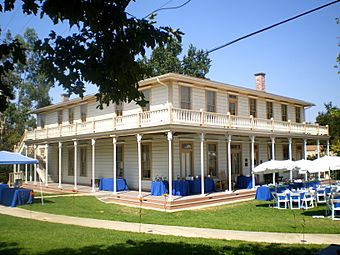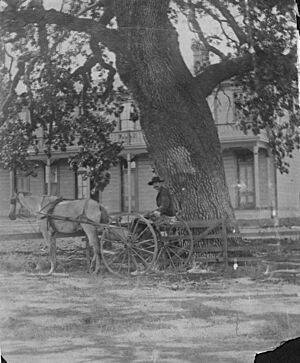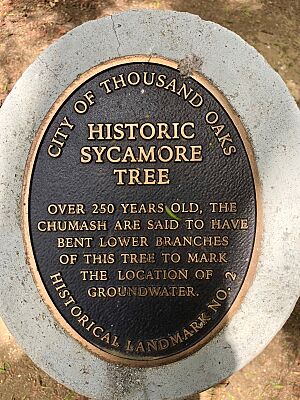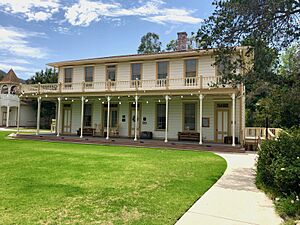Stagecoach Inn (California) facts for kids
The Stagecoach Inn Museum in Newbury Park, California, was once known as the Grand Union Hotel. It was a popular resting spot for people traveling between Los Angeles and Santa Barbara. Over the years, it has been more than just a hotel and stagecoach stop. It also served as a post office, a church, a restaurant, and even a military school!
This historic building is a California Historical Landmark (No. 659). It is also listed on the National Register of Historic Places. The inn played a big part in creating the stagecoach travel network in California. It was also the very first business in the Conejo Valley.
Today, the Conejo Recreation and Park Department owns the inn. It is run as a fun and educational history museum. The museum grounds feature a rebuilt Timber School from 1889. You can also see a carriage house, a blacksmith shop, and nature trails. There is a special area called the "Tri-Village." This area has three different types of homes: a pioneer house, an adobe house, and a Chumash "ap" (a traditional house). You can find a gift shop inside the museum too.
The museum is managed by a director and many helpful volunteers. These volunteers are part of the Conejo Valley Historical Society. There's even a "Jr. Docent" program for kids and teens aged 8–18. The Stagecoach Inn Museum is a key place for learning and gathering for thousands of people in Newbury Park. Some people even say the Stagecoach Inn Museum is haunted! It is known as one of California's most famous haunted places.
Contents
The Inn's Many Names and Owners
The Stagecoach Inn Museum has had several names and owners throughout its long history:
- 1876-1878: James Hammell owned it as the Grand Union Hotel and El Grande Hotel.
- 1878-1885: J.B. Redfield called it the Hammell House.
- 1885-1926: Cecil and Cicelie Haigh named it the Conejo Hotel at Timberville, later known as the Big Hotel.
- 1926-1957: Simon and Ethel Hays used several names, including The Old Hotel and Roadhouse.
- 1957-1964: H. Allen Hays owned it. The Conejo Recreation and Park District started running it in 1964.
A Look Back at the Inn's History

James Hammell was a carpenter from Santa Barbara. He wanted to build a hotel along the stagecoach route between Los Angeles and Santa Barbara. In the late 1800s, he bought 4,200 acres of land. Hammell began building the hotel in 1876 near what is now Highway 101 and Ventu Park Road.
The Grand Union Hotel was meant to be a stop for travelers. It was built using strong redwood lumber. This wood was brought by sea from Northern California to Port Hueneme. From there, wagons pulled by many animals carried it up the Conejo Grade.
Just one month before the hotel was supposed to open, the Coast Line Stage Company changed its route. This meant stagecoaches would no longer pass through Conejo Valley. This was bad news for Hammell's plans for a busy stage stop. But Hammell didn't give up! He opened the hotel in August 1876, even though he had planned for July 4th.
The hotel was advertised as a "health and pleasure resort." A local newspaper said visitors could enjoy "Shooting, fishing, bathing, and a first-rate table."
After a dry period in 1877-78, James Hammell sold the hotel. It had several owners before Cecil Haigh bought it in 1885. Years later, Cecil's grandson, H. Allen Hays, gave the building and about four acres of land to the Conejo Valley Historical Society. They then gave the property to the Conejo Recreation and Park District. In return, the society received a long-term lease to run the museum.
In the 1960s, the hotel was almost torn down because the Ventura Freeway was expanding. But it was saved by being named a Historical Landmark. It was then moved to its current spot in 1966. Sadly, a fire destroyed the museum and everything inside it on April 25, 1970.
The museum was rebuilt using its original Monterey-style architecture. It officially reopened on July 4, 1976. The second floor was finished a few years later in 1980.
Important Historic Designations
The Stagecoach Inn Museum has received many important recognitions:
- It became Ventura County Historic Landmark No. 30 in 1976.
- It was named a California Historical Landmark No. 659.
- It was added to the U.S. National Register of Historic Places in 1975.
- It is also City of Thousand Oaks Historical Landmark No. 1.
The museum grounds also feature a copy of the 1889 Timber School. On July 13, 2004, the original 1924 Timber School on Newbury Road was declared City Landmark No. 12.
The Historic Sycamore Tree
Near the Tri-Village Complex on the museum grounds stands a very old sycamore tree. This tree is over 250 years old! It was named Ventura County Landmark No. 44 in June 1978. This was because of its "great age, size, and formation." It is also Thousand Oaks City Landmark No. 2.
General John C. Frémont passed by this tree in 1846. He was on his way to sign a treaty that helped California become part of the U.S. The Chumash Indians are believed to have bent the lower branches of the tree. This was a way to mark where underground water could be found.
What You Can See at the Museum
The museum has many interesting things to see. These include the Carriage House, Blacksmith Shop, Anderson Exhibit Hall, Tri-Village, and Timber School. The Tri-Village shows three different time periods in the Conejo Valley. It has the Newbury Pioneer House, a Spanish Adobe, and a rebuilt Chumash village.
The exhibits change often, so there's always something new to discover. In July 2018, some temporary exhibits included Jungleland USA, old-fashioned dresses, and fossils from the Conejo Valley. Past exhibits have shown minerals, shells, old record players, irons, laundry tools, and even Chumash pictographs (rock paintings).
- Stagecoach Inn Museum: The main part of the museum is the rebuilt 1876 hotel. Here, you can see items related to local history, American history, and the Victorian era. Upstairs, you can explore rooms set up like they would have looked for families and travelers. Some rooms also feature changing exhibits. The Emporium, a gift shop, is on the main floor.
- Anderson Exhibit Hall: This hall is on the lower level of the hotel. It has its own entrance. Here, you'll find permanent displays of Chumash artifacts. There are also items about the local natural history and archaeology, including fossils.
- Nature Trails: Two paths, each about 0.5 miles (0.8 km) long, start behind the Inn. They lead to the Tri-Village. One path follows a stream through an oak tree forest. You can see many native plants along the way.
- Tri-Village Complex: This area has three structures that show different historical periods in the Conejo Valley. The Chumash Native Americans are shown with a rebuilt "ap" house. Mexican vaqueros (cowboys) are represented by an adobe house with a beehive oven. Early American pioneers are shown with a wooden house, like the rebuilt Egbert Starr Newbury house from 1874. The Tri-Village is also home to the 250-plus year old Sycamore tree.
- Timber School: This is a rebuilt schoolhouse from 1889. The original school was located near Newbury and Kelley Roads.
- Carriage House and Blacksmith Shop: You can also find a carriage house, a windmill, and a blacksmith shop here. The Carriage House has a real 19th-century stagecoach. It also displays old tools for farming and broom-making. The blacksmith shop uses antique tools from local ranches.
- Heritage Rose Garden: This garden has over 35 types of old-fashioned roses. Some date back to 1752! A path made of memorial bricks winds through the garden.
Stagecoach Inn Museum Park
Right next to the Stagecoach Inn Museum is the Stagecoach Inn Museum Park. It is located at the corner of Lynn and Ventu Park Roads. The Conejo Recreation & Park District bought the park land in 1968. It was later turned into a neighborhood park in 1985. A small creek runs along one side of the park. The park has a playground, picnic tables, barbecue grills, and an outdoor basketball court.
From the park, you can reach the Rosewood Trail. This trail leads to Angel Vista, a 1,603-foot (489 m) peak in the Santa Monica Mountains. Hikers can park at the museum park and find the Rosewood Trailhead right across Lynn Road.
Conejo Valley Historical Society
The Conejo Valley Historical Society started on October 9, 1964. Its main goal was to save the Stagecoach Inn. The inn was in danger of being torn down because the Ventura Freeway was expanding. The society's members successfully saved the building. They also helped it become California State Landmark No. 659.
H. Allen Hays, whose grandparents once owned the inn, donated the building and about four acres of land to the society. The society then gave the site to the Conejo Recreation and Park District (CRPD). In return, they received a renewable lease to operate and manage the complex as a museum. The society helped get the inn ready as a museum after it was moved in 1966. After the fire in April 1970, the society immediately made plans to rebuild the structure.
The Conejo Valley Historical Society often holds meetings and events at the Stagecoach Inn Museum.
See also






